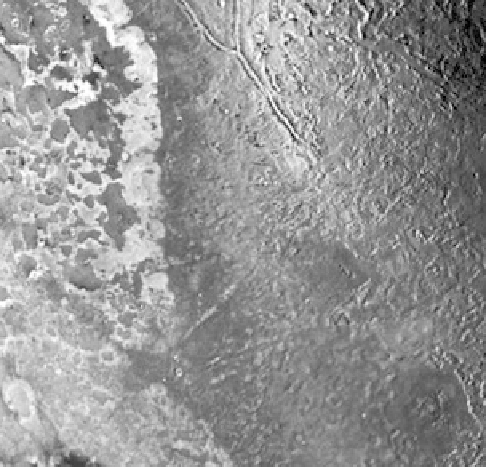Geology Reference
In-Depth Information
Figure 10.12. Detail of the boundary between the
”
terrain, characterized by ridges, grooves, and irregular domes, and the
smooth plain with its mottled surface (NASA Voyager JPL P-34694).
“
cantaloupe
Figure 10.14. The dark wind streaks seen in the smooth plains
are deposits left by explosively erupting plumes of material
caught by upper-altitude winds and carried downwind toward the
lower left; these streaks are as long as 100 km (NASA Voyager
PIA34714).
Triton is the
fifth object in the Solar System known
to have active eruptions; several active geysers were
seen during the Vo y ag e r flyby. The geysers spewed
material as high as 8 km above the surface, where it
was caught by upper-altitude winds and carried down-
wind some 100 km, leaving dark deposits on the
surface (
Fig. 10.14
). Analysis of images revealed
many more such dark surface streaks, suggesting that
the eruptions are common. Although many ideas have
been proposed to explain the process of geyser activity,
the current concept is that they are a type of solid state
“
greenhouse,
”
which is similar to the explanation for the
“
terrain on Mars (in fact, the idea was first
proposed for Titan and then modi
ed for application
to Mars). Nitrogen-ice, a common component on
Triton
'
is surface, is transparent in its pure form. Thus,
solar energy penetrates through the nitrogen-ice and is
trapped. Only a 4 K rise in temperature is needed to
volatilize the nitrogen-ice at its base, and the resulting
build-up of gas pressure can reach suf
cient levels to
rupture the overlying ice to release the gas explosively.
The dark material could be silicates or carbonaceous
material carried upward from deposits along the inter-
face of the ice and the substrate.
spider
”
Figure 10.13. Large caldera-like depressions are found in Triton
'
s
smooth plains and are considered to be sites of cryovolcanic
eruptions of liquids from the subsurface; area shown here is about
290 km across (NASA Voyager JPL-34692).
depressions resembling volcanic calderas (
Fig. 10.13
),
and many are considered to be sites where liquid water,
nitrogen, and methane erupted from the subsurface to
form local lakes.





